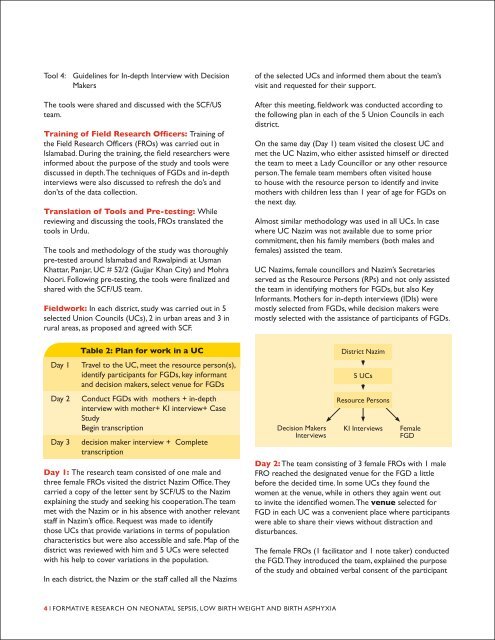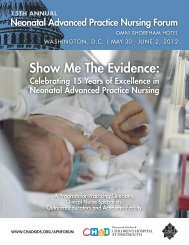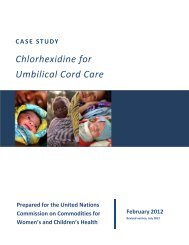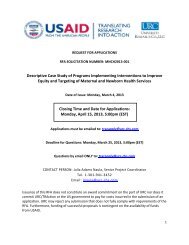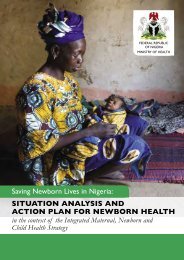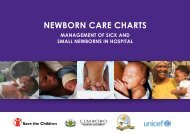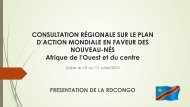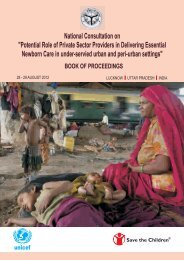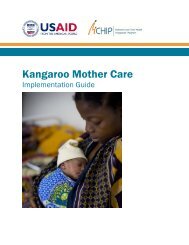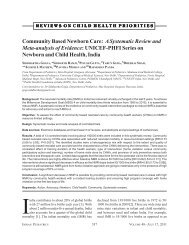Download Resource - Healthy Newborn Network
Download Resource - Healthy Newborn Network
Download Resource - Healthy Newborn Network
Create successful ePaper yourself
Turn your PDF publications into a flip-book with our unique Google optimized e-Paper software.
Tool 4: Guidelines for In-depth Interview with Decision<br />
Makers<br />
The tools were shared and discussed with the SCF/US<br />
team.<br />
Training of Field Research Officers: Training of<br />
the Field Research Officers (FROs) was carried out in<br />
Islamabad. During the training, the field researchers were<br />
informed about the purpose of the study and tools were<br />
discussed in depth. The techniques of FGDs and in-depth<br />
interviews were also discussed to refresh the do’s and<br />
don’ts of the data collection.<br />
Translation of Tools and Pre-testing: While<br />
reviewing and discussing the tools, FROs translated the<br />
tools in Urdu.<br />
The tools and methodology of the study was thoroughly<br />
pre-tested around Islamabad and Rawalpindi at Usman<br />
Khattar, Panjar, UC # 52/2 (Gujjar Khan City) and Mohra<br />
Noori. Following pre-testing, the tools were finalized and<br />
shared with the SCF/US team.<br />
Fieldwork: In each district, study was carried out in 5<br />
selected Union Councils (UCs), 2 in urban areas and 3 in<br />
rural areas, as proposed and agreed with SCF.<br />
Day 1<br />
Day 2<br />
Day 3<br />
Table 2: Plan for work in a UC<br />
Travel to the UC, meet the resource person(s),<br />
identify participants for FGDs, key informant<br />
and decision makers, select venue for FGDs<br />
Conduct FGDs with mothers + in-depth<br />
interview with mother+ KI interview+ Case<br />
Study<br />
Begin transcription<br />
decision maker interview + Complete<br />
transcription<br />
Day 1: The research team consisted of one male and<br />
three female FROs visited the district Nazim Office. They<br />
carried a copy of the letter sent by SCF/US to the Nazim<br />
explaining the study and seeking his cooperation. The team<br />
met with the Nazim or in his absence with another relevant<br />
staff in Nazim’s office. Request was made to identify<br />
those UCs that provide variations in terms of population<br />
characteristics but were also accessible and safe. Map of the<br />
district was reviewed with him and 5 UCs were selected<br />
with his help to cover variations in the population.<br />
In each district, the Nazim or the staff called all the Nazims<br />
of the selected UCs and informed them about the team’s<br />
visit and requested for their support.<br />
After this meeting, fieldwork was conducted according to<br />
the following plan in each of the 5 Union Councils in each<br />
district.<br />
On the same day (Day 1) team visited the closest UC and<br />
met the UC Nazim, who either assisted himself or directed<br />
the team to meet a Lady Councillor or any other resource<br />
person. The female team members often visited house<br />
to house with the resource person to identify and invite<br />
mothers with children less than 1 year of age for FGDs on<br />
the next day.<br />
Almost similar methodology was used in all UCs. In case<br />
where UC Nazim was not available due to some prior<br />
commitment, then his family members (both males and<br />
females) assisted the team.<br />
UC Nazims, female councillors and Nazim’s Secretaries<br />
served as the <strong>Resource</strong> Persons (RPs) and not only assisted<br />
the team in identifying mothers for FGDs, but also Key<br />
Informants. Mothers for in-depth interviews (IDIs) were<br />
mostly selected from FGDs, while decision makers were<br />
mostly selected with the assistance of participants of FGDs.<br />
Decision Makers<br />
Interviews<br />
District Nazim<br />
5 UCs<br />
<strong>Resource</strong> Persons<br />
KI Interviews<br />
Female<br />
FGD<br />
Day 2: The team consisting of 3 female FROs with 1 male<br />
FRO reached the designated venue for the FGD a little<br />
before the decided time. In some UCs they found the<br />
women at the venue, while in others they again went out<br />
to invite the identified women. The venue selected for<br />
FGD in each UC was a convenient place where participants<br />
were able to share their views without distraction and<br />
disturbances.<br />
The female FROs (1 facilitator and 1 note taker) conducted<br />
the FGD. They introduced the team, explained the purpose<br />
of the study and obtained verbal consent of the participant<br />
4 l Formative Research on Neonatal Sepsis, Low Birth Weight AND Birth Asphyxia


